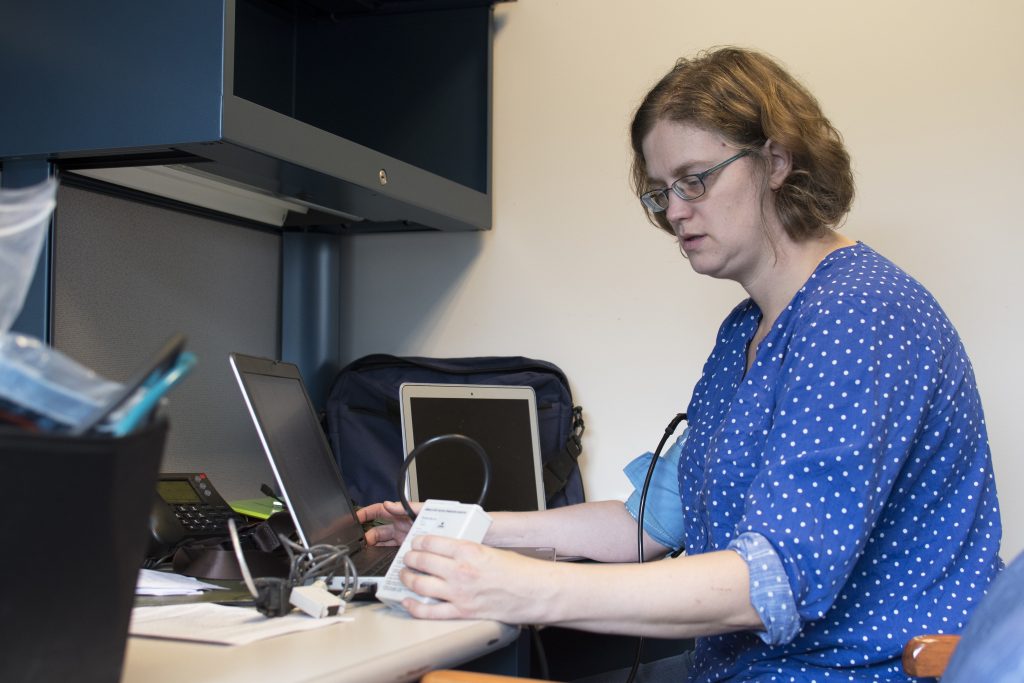
Binghamton University students and faculty are sporting 24-hour blood pressure monitors around campus and at home for a new research study focusing on nicotine use.
The study uses an ambulatory blood pressure monitor (ABPM), consisting of a standard blood pressure arm cuff and an electronic recording device typically worn on the waist, to measure variations in subjects’ blood pressure throughout the day and night. Susan Mueller, a second-year Ph.D. student studying nursing, is heading the research for her dissertation.
Once research participants are fitted with the ABPM, they go about their routine as they would any other day. For the next 24 hours, the monitoring system will take a blood pressure reading every 15 minutes during the day and every 30 minutes throughout the night. The monitor gives an audible warning a few minutes before taking the reading.
About 60 students and faculty make up the two test groups, one representing nicotine users and the other representing those who do not use nicotine. Only University-affiliated people are permitted into the test groups, as the study is primarily funded by the National Consortium for Building Healthy Academic Communities, a group that aims to promote healthy living on university campuses throughout the United States, according to their website.
Journals are also given to the participants so they can document their activities and location while their blood pressure is being measured. After the 24-hour session is complete and the data is uploaded to a Microsoft Excel sheet, the journal entries will be added so they can be statistically analyzed and researchers can compare participants’ actions to their blood pressure.
“My curiosity doesn’t stop at just smoking,” Mueller said. “I want to know how blood pressure is affected when they drink a Pepsi or go for a run, so that’s why we have them fill out the journal.”
The results of the test are prepared for participants a few days after the session, a free report that is typically worth $200, according to Mueller. A month after the session, participants also have the opportunity to earn a $25 stipend for filling out a follow-up survey.
Gary James, co-investigator of the Interdisciplinary Tobacco Use Research Program (ITURP) and a distinguished service professor of anthropology, is assisting Mueller with the research. ITURP is a Decker School of Nursing initiative that works to promote campus research, including Mueller’s study.
James said his involvement in Mueller’s study is primarily as the ABPM professional, after having a hand in developing the instrument and also working in the Decker School of Nursing from 1998 to 2013. According to James, the ABPM helps solve a major issue standard blood pressure tests have.
“We have this conundrum that people seem to have exactly the same blood pressure whether they drop dead to a heart attack the next week or they live to be a hundred,” James said. “[The ABPM] got developed to look at what your blood pressure is like when you’re not in the doctor’s office, initially used more for a cardiological purpose, to actually do a 24-hour evaluation of somebody’s cardiovascular system.”
Now the ABPM has moved beyond health services and is being used for research for the same mobile advantages. James said this instrument will now help accurately measure blood pressure during day-to-day activities.
“When I was working on all this stuff as a biological anthropologist, I recognized that you can do some other things with this,” James said. “Because what are people doing out there? They’re behaving, they’re smoking, they’re drinking alcohol, they’re having sex, they’re doing whatever it is that they’re doing and you can actually chart what their blood pressure is with regard to what they’re doing and how they’re feeling.”


